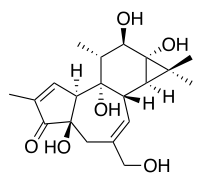Phorbol
 | |
| Names | |
|---|---|
| IUPAC name
1,1a,1b,4,4a,7a,7b,8,9,9a-decahydro-4a,7b,9,9a-tetrahydroxy-3-(hydroxymethyl)-1,1,6,8-tetramethyl-5H-cyclopropa[3,4]benz[1,2-e]azulen-5-one | |
| Identifiers | |
| 17673-25-5 | |
| ChemSpider | 390610 |
| |
| Jmol-3D images | Image |
| PubChem | 442070 |
| |
| Properties | |
| C20H28O6 | |
| Molar mass | 364.44 g/mol |
| Melting point | 250 to 251 °C (482 to 484 °F; 523 to 524 K) |
| Except where noted otherwise, data is given for materials in their standard state (at 25 °C (77 °F), 100 kPa) | |
| | |
| Infobox references | |
Phorbol is a natural, plant-derived organic compound. It is a member of the tigliane family of diterpenes. Phorbol was first isolated in 1934 as the hydrolysis product of croton oil, which is derived from the seeds of the purging croton, Croton tiglium.[2][3][4][5][6] The structure of phorbol was determined in 1967.[7][8] It is very soluble in most polar organic solvents, as well as in water.
Various esters of phorbol have important biological properties, the most notable of which is the capacity to act as tumor promoters through activation of protein kinase C.[9] They mimic diacylglycerols, glycerol derivatives in which two hydroxyl groups have reacted with fatty acids to form esters. The most common phorbol ester is 12-O-tetradecanoylphorbol-13-acetate (TPA), also called phorbol-12-myristate-13-acetate (PMA), which is used as a biomedical research tool in models of carcinogenesis. TPA, together with ionomycin, can also be used to stimulate T-cell activation, proliferation, and cytokine production, and is used in protocols for intracellular staining of these cytokines.[10]
References
- ↑ Merck Index, 11th Edition, 7306
- ↑ Flaschenträger B, v. Wolffersdorff R (1934). "Über den Giftstoff des Crotonöles. 1. Die Säuren des Crotonöles". Helvetica Chimica Acta 17 (1): 1444–1452. doi:10.1002/hlca.193401701179.
- ↑ Flaschenträger B, Wigner G (1942). "Über den Giftstoff des Crotonöles. V. Die Gewinnung von Crotonharz, Dünnem Öl und Phorbol aus dem Crotonöl durch Alkoholyse". Helvetica Chimica Acta 25 (3): 569–581. doi:10.1002/hlca.19420250315.
- ↑ Kauffmann T, Neumann H, Lenhardt K (1959). "Zur Konstitution des Phorbols, I. Über die reduzierende Gruppe des Phorbols". Chemische Berichte 92 (8): 1715–1726. doi:10.1002/cber.19590920802.
- ↑ Kauffmann T, Eisinger A, Jasching W, Lenhardt K (1959). "Zur Konstitution des Phorbols, I. Über die reduzierende Gruppe des Phorbols". Chemische Berichte 92 (8): 1727–1738. doi:10.1002/cber.19590920803.
- ↑ Tseng S-S, van Duuren BL, Solomon JJ (1977). "Synthesis of 4aα-Phorbol 9-Myristate 9a-Acetate and Related Esters". J. Org. Chem. 42 (33): 3645–3649. doi:10.1021/jo00443a002.
- ↑ Hecker E, Bartsch H, Bresch H, Gschwendt M, Härle B, Kreibich G, Kubinyi H, Schairer HU, v. Szczepanski C, Thielmann HW (1967). "Structure and Stereochemistry of the Tetracyclic Diterpene Phorbol from Croton tiglium L". Tetrahedron Letters 8 (33): 3165–3170. doi:10.1016/S0040-4039(01)89890-7.
- ↑ Pettersen RC, Ferguson G, Crombie L, Games ML, Pointer DJ (1967). "The Structure and Stereochemistry of Phorbol, Diterpene Parent of Co-carcinogens of Croton Oil". Chem. Commun. (London) 1967 (14): 716–717. doi:10.1039/C19670000716.
- ↑ Blumberg PM (1988). "Protein Kinase C as the Receptor for the Phorbol Ester Tumor Promoters: Sixth Rhoads Memorial Award Lecture" (PDF). Cancer Res. 48 (1): 1–8. PMID 3275491.
- ↑ "Flow Cytometry Intracellular Staining Guide". eBioscience, Inc. Retrieved 2011-09-25.
External links
- Phorbols at the US National Library of Medicine Medical Subject Headings (MeSH)
| Wikimedia Commons has media related to Phorbols. |